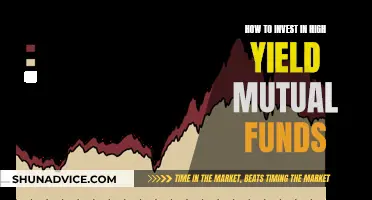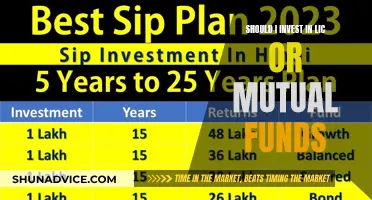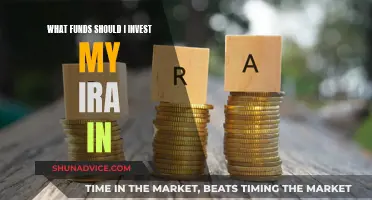
A feeder fund is a type of investment fund that acts as a vehicle for investors to put their money into a hedge fund's combined cash, which is then used to invest in shares of a master fund. It is part of a master-feeder structure, where the feeder fund collects money from investors and the master fund is where the actual investing happens. The feeder fund is one of several sub-funds that put all their investment capital into the master fund, which is handled by a single investment advisor. The master fund then holds investments such as commercial real estate or a diversified portfolio of stocks. The feeder fund structure is commonly used by hedge funds to pool the resources of both US and foreign investors, and to reduce fees and administrative burdens.
| Characteristics | Values |
|---|---|
| Type of investment fund | Feeder fund |
| Fund structure | Master-feeder structure |
| Investment vehicle | Hedge fund |
| Investor type | Accredited investors, institutional investors, high-net-worth individuals |
| Investor location | U.S. and foreign investors |
| Investor number | Larger pool of investors |
| Investment strategy | Reduced fees and administrative burden |
| Investment destination | Master fund |
| Investment management | Master fund's investment advisor |
| Investment objective | Identical to master fund |
| Investment performance | Proportionate distribution of profits |
| Trading costs | Lower trading costs |
| Tax treatment | Pass-through tax treatment, withholding tax |
What You'll Learn

Feeder funds are a type of investment fund
A feeder fund is a fund that can be used as a vehicle to invest in other funds, generally through a hedge fund manager. Investors choose the feeder fund they wish to put their money into based on the fees, minimum amounts, and other characteristics. Feeder funds are exactly what they sound like: funds that tend to feed into bigger funds. However, they are not required to feed into the same fund exclusively.
Feeder funds are one of several sub-funds that put all of their investment capital into an overarching umbrella fund, known as a master fund. For this master fund, a single investment advisor handles all portfolio investments and trading. This two-tiered investment structure is commonly used by hedge funds as a means of assembling a larger portfolio account by pooling investment capital. The primary purpose served by the feeder fund-master fund structure is the reduction of trading costs and overall operating costs. The master fund effectively achieves economies of scale through having access to the large pool of investment capital provided by a number of feeder funds, which enables it to operate less expensively than would be possible for any of the feeder funds investing on their own.
The feeder fund is the fund in which all the money from investors is collected. Generally, several feeder funds with varying characteristics work together. They can buy shares of master funds, typically involving a primary fund the feeders are associated with, but sometimes other funds, too. Master funds, on the other hand, are where the investing actually happens. These funds hold investments, such as commercial real estate, a diversified portfolio of stocks, or a highly diversified basket of other assets.
The average master-feeder structure involves one offshore master fund with one onshore feeder and one offshore feeder. Feeder funds investing in the same master fund have the option of choice and variation. In other words, the feeders may differ in investor type, fee structures, investment minimums, net asset values, and various other operational attributes.
Actively Managed Mutual Funds: Understanding Diverse Investments
You may want to see also

They are part of a master-feeder structure
Feeder funds are part of a master-feeder structure, a device commonly used by hedge funds to pool the resources of both U.S. and foreign investors. This structure is designed to accommodate both U.S. and non-U.S. investors, with separate investment vehicles (or feeders) established for each group. The investors put their capital into their respective feeder funds, which ultimately invest in a centralised vehicle known as the master fund.
The master fund is responsible for making all portfolio investments and conducting all trading activity. It is the master fund, not the feeder fund, that the hedge fund's investment advisor uses to invest in the market. The master fund holds investments such as commercial real estate, a diversified portfolio of stocks, or a highly diversified basket of other assets.
The feeder fund is the fund in which all the money from investors is collected. Generally, several feeder funds with varying characteristics work together, pooling investor money, which is then aggregated under a single centralised master fund. The feeder funds each have different fees and requirements, even if they feed into the same master fund.
The primary purpose of the master-feeder structure is to reduce trading costs and overall operating costs. The master fund achieves economies of scale by having access to the large pool of investment capital provided by a number of feeder funds, enabling it to operate less expensively than would be possible for any of the feeder funds investing on their own. The consolidation of feeder funds into a master fund also allows for reductions in operational and trading costs.
The master-feeder structure also allows funds to benefit from favourable "pass-through" tax treatment. In the case of an offshore master fund, however, U.S. dividends are subject to a 30% withholding tax for U.S. investors, with financial penalties if the fund doesn't withhold it.
Superannuation Fund: A Managed Investment Scheme?
You may want to see also

Feeder funds pool investor money
The master fund is where the actual investing happens. It holds investments such as commercial real estate, a diversified portfolio of stocks, or a highly diversified basket of other assets. The feeder funds each have different fees and requirements, even if they feed into the same master fund. When an investor puts money into a feeder fund, the fund manager uses the money to buy shares in the master fund. The master fund's holdings are the investment, and the feeder fund is simply a way to pool money to build a bigger portfolio.
The primary purpose of the feeder fund-master fund structure is to reduce trading costs and overall operating costs. The master fund achieves economies of scale by having access to a large pool of investment capital provided by the feeder funds, which enables it to operate less expensively than if the feeder funds were investing on their own. This two-tiered fund structure can be advantageous when the feeder funds share common investment goals and strategies. However, it may not be suitable for a feeder fund with a unique investment strategy or aim, as those characteristics may be lost in the combination with other funds within the master fund.
The average master-feeder structure involves one offshore master fund with one onshore feeder and one offshore feeder. The onshore feeder fund is for U.S. taxable investors, while the offshore feeder fund is for foreign investors and U.S. tax-exempt investors. This structure allows hedge funds to accommodate both U.S. and non-U.S. investors and benefit from economies of scale and favourable "pass-through" tax treatment.
Index Fund Investment: Is the Minimum Enough?
You may want to see also

Feeder funds are used by hedge funds
The feeder fund is the fund in which all the money from investors is collected. Hedge funds commonly use master-feeder structures, where fees generated are pro-rated and distributed to the feeder funds. The feeder fund is a vehicle through which investors put their money into a hedge fund's combined cash to invest, which is then spent on investing in shares of a master fund.
The master fund is responsible for making all portfolio investments and conducting all trading activity. The master fund is what the hedge fund's investment advisor ultimately uses to invest in the market. The master fund, therefore, has access to a large pool of investment capital provided by a number of feeder funds, which enables it to operate less expensively than would be possible for any of the feeder funds investing on their own.
The feeder fund-master fund structure is designed to reduce trading costs and overall operating costs. The master fund achieves economies of scale through having access to the large pool of investment capital provided by a number of feeder funds.
DFA Funds: Smart Investment, Diversified Returns
You may want to see also

Feeder funds are only open to certain investors
Feeder funds are a type of investment fund that hedge fund investors put their money into, which then feeds into a master fund. The master fund, not the feeder fund, is what the hedge fund's investment advisor ultimately uses to invest in the market. This two-tiered investment structure is commonly used by hedge funds as a means of assembling a larger portfolio account by pooling investment capital.
The feeder fund is a vehicle through which investors put their money into a hedge fund's combined cash to invest, which is then spent on investing in shares of a master fund. Hedge funds commonly use master-feeder structures, where fees generated are pro-rated and distributed to the feeder funds.
The primary purpose served by the feeder fund-master fund structure is the reduction of trading costs and overall operating costs. The master fund effectively achieves economies of scale through having access to the large pool of investment capital provided by a number of feeder funds, which enables it to operate less expensively than would be possible for any of the feeder funds investing on their own.
Index Funds: Diversified, Low-Cost, Long-Term Investment Strategy
You may want to see also
Frequently asked questions
A feeder fund is a type of investment fund that acts as a vehicle for investors to pool their money, which then feeds into a larger fund known as a master fund.
Investors choose a feeder fund based on fees, minimum amounts, and other characteristics. The feeder fund then collects this money and invests it in a master fund, which is used to purchase shares or other assets. The master fund's performance determines the bulk of the investment value.
A feeder fund is the fund in which investor money is initially collected. It is one of several sub-funds that contribute capital to the master fund. The master fund is the overarching fund that makes all the portfolio investments and conducts trading activities.
Feeder funds can provide access to a larger portfolio of investments without the need for individual research. They also benefit from reduced costs due to economies of scale, and they cater to both domestic and international investors.
Feeder funds may struggle to cater to the specific goals of individual investors, as they are often combined with other funds. Additionally, they may be subject to withholding taxes, and the large pool of investors with varying characteristics can make it challenging to find a suitable investment strategy.







